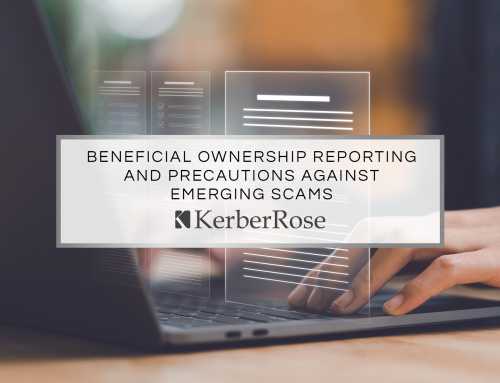How will the Credit for Child and Dependent Care Expenses Affect You?
Are you a parent who paid for childcare in 2021? If so, you may get a nice surprise at tax time.
The American Rescue Plan (ARP) of 2021 enhanced the credit many parents will receive. The credit for child and dependent care expenses has been around for many years, and the ARP changed the rules for 2021. Some legislators in Washington DC have suggested modifying the credit for 2022 and beyond, yet no legislation has been passed.
Here’s what parents need to know about the changes to the child and dependent care credit for 2021:
Allowable Expenses – The allowable expenses limit has been increased. In the past, parents were allowed to claim a credit on up to $3,000 of childcare expenses for one child and up to $6,000 for more than one child. For 2021, allowable expenses are limited to $8,000 for one child and $16,000 for more than one child.
Credit Percentage – The credit is calculated as a percentage of allowable expenses, and the percentage is determined by how much income a family received in the current year. The percentage decreased as family incomes increased up to a certain amount. In 2020, low income parents with income of $15,000 or less received the maximum credit of 35%. For parents with income more than $43,000, the credit was 20% of allowable expenses. There was no upper limit to who could claim the credit, and even parents with very high income were allowed a credit of 20% of qualified expenses.
For 2021, the credit percentage is a maximum of 50% for parents with income of $125,000 or less. For those with income over $125,000 and less than $183,000, the credit percentage decreases gradually down to 20%. For those with income between $183,000 and $400,000 the credit is 20%. The credit percentage decreases for those with income above $400,000, and for those with income above $438,000, no credit is allowed.
The Credit is Refundable – For 2021, the credit is refundable for most parents if they lived in the United States. In the past, the credit was nonrefundable, meaning the credit could only be used to offset tax. For low income parents, a nonrefundable credit might not save them any money because their federal income tax might be relatively low, and it might be offset by other credits. In 2021, the credit is fully refundable. This will mean all parents eligible for the credit will get a benefit, even if their income is relatively low and they don’t pay any federal tax.
How Much will Parents Save? – For many families in Wisconsin, this question is a big deal. For example, let’s consider a two-parent family with each parent earning $50,000 and childcare expenses for two children totaling $14,000. In 2020, this family’s credit would be 20% of the first $3,000 for each child, totaling $1,200. For 2021, this family’s credit will be 50% of all their childcare expenses, totaling $7,000. That’s an increased credit of $5,800 in this example, and since the credit is refundable, a family like this will almost certainly get the full benefit of the credit.
Parents with higher income will be negatively impacted by the change in 2021. Those with income above $438,000 will not get any credit, and this may cost them $1,200 if they got the maximum credit in 2020.
Want to Understand how the Credit for Child and Dependent Care Expenses Affects You? The tax professionals at KerberRose are available to answer your questions about individual tax matters, including the credit for child and dependent care expenses. Contact our team of tax professionals today!
How will the Credit for Child and Dependent Care Expenses Affect You?
Are you a parent who paid for childcare in 2021? If so, you may get a nice surprise at tax time.
The American Rescue Plan (ARP) of 2021 enhanced the credit many parents will receive. The credit for child and dependent care expenses has been around for many years, and the ARP changed the rules for 2021. Some legislators in Washington DC have suggested modifying the credit for 2022 and beyond, yet no legislation has been passed.
Here’s what parents need to know about the changes to the child and dependent care credit for 2021:
Allowable Expenses – The allowable expenses limit has been increased. In the past, parents were allowed to claim a credit on up to $3,000 of childcare expenses for one child and up to $6,000 for more than one child. For 2021, allowable expenses are limited to $8,000 for one child and $16,000 for more than one child.
Credit Percentage – The credit is calculated as a percentage of allowable expenses, and the percentage is determined by how much income a family received in the current year. The percentage decreased as family incomes increased up to a certain amount. In 2020, low income parents with income of $15,000 or less received the maximum credit of 35%. For parents with income more than $43,000, the credit was 20% of allowable expenses. There was no upper limit to who could claim the credit, and even parents with very high income were allowed a credit of 20% of qualified expenses.
For 2021, the credit percentage is a maximum of 50% for parents with income of $125,000 or less. For those with income over $125,000 and less than $183,000, the credit percentage decreases gradually down to 20%. For those with income between $183,000 and $400,000 the credit is 20%. The credit percentage decreases for those with income above $400,000, and for those with income above $438,000, no credit is allowed.
The Credit is Refundable – For 2021, the credit is refundable for most parents if they lived in the United States. In the past, the credit was nonrefundable, meaning the credit could only be used to offset tax. For low income parents, a nonrefundable credit might not save them any money because their federal income tax might be relatively low, and it might be offset by other credits. In 2021, the credit is fully refundable. This will mean all parents eligible for the credit will get a benefit, even if their income is relatively low and they don’t pay any federal tax.
How Much will Parents Save? – For many families in Wisconsin, this question is a big deal. For example, let’s consider a two-parent family with each parent earning $50,000 and childcare expenses for two children totaling $14,000. In 2020, this family’s credit would be 20% of the first $3,000 for each child, totaling $1,200. For 2021, this family’s credit will be 50% of all their childcare expenses, totaling $7,000. That’s an increased credit of $5,800 in this example, and since the credit is refundable, a family like this will almost certainly get the full benefit of the credit.
Parents with higher income will be negatively impacted by the change in 2021. Those with income above $438,000 will not get any credit, and this may cost them $1,200 if they got the maximum credit in 2020.
Want to Understand how the Credit for Child and Dependent Care Expenses Affects You? The tax professionals at KerberRose are available to answer your questions about individual tax matters, including the credit for child and dependent care expenses. Contact our team of tax professionals today!
How will the Credit for Child and Dependent Care Expenses Affect You?
Are you a parent who paid for childcare in 2021? If so, you may get a nice surprise at tax time.
The American Rescue Plan (ARP) of 2021 enhanced the credit many parents will receive. The credit for child and dependent care expenses has been around for many years, and the ARP changed the rules for 2021. Some legislators in Washington DC have suggested modifying the credit for 2022 and beyond, yet no legislation has been passed.
Here’s what parents need to know about the changes to the child and dependent care credit for 2021:
Allowable Expenses – The allowable expenses limit has been increased. In the past, parents were allowed to claim a credit on up to $3,000 of childcare expenses for one child and up to $6,000 for more than one child. For 2021, allowable expenses are limited to $8,000 for one child and $16,000 for more than one child.
Credit Percentage – The credit is calculated as a percentage of allowable expenses, and the percentage is determined by how much income a family received in the current year. The percentage decreased as family incomes increased up to a certain amount. In 2020, low income parents with income of $15,000 or less received the maximum credit of 35%. For parents with income more than $43,000, the credit was 20% of allowable expenses. There was no upper limit to who could claim the credit, and even parents with very high income were allowed a credit of 20% of qualified expenses.
For 2021, the credit percentage is a maximum of 50% for parents with income of $125,000 or less. For those with income over $125,000 and less than $183,000, the credit percentage decreases gradually down to 20%. For those with income between $183,000 and $400,000 the credit is 20%. The credit percentage decreases for those with income above $400,000, and for those with income above $438,000, no credit is allowed.
The Credit is Refundable – For 2021, the credit is refundable for most parents if they lived in the United States. In the past, the credit was nonrefundable, meaning the credit could only be used to offset tax. For low income parents, a nonrefundable credit might not save them any money because their federal income tax might be relatively low, and it might be offset by other credits. In 2021, the credit is fully refundable. This will mean all parents eligible for the credit will get a benefit, even if their income is relatively low and they don’t pay any federal tax.
How Much will Parents Save? – For many families in Wisconsin, this question is a big deal. For example, let’s consider a two-parent family with each parent earning $50,000 and childcare expenses for two children totaling $14,000. In 2020, this family’s credit would be 20% of the first $3,000 for each child, totaling $1,200. For 2021, this family’s credit will be 50% of all their childcare expenses, totaling $7,000. That’s an increased credit of $5,800 in this example, and since the credit is refundable, a family like this will almost certainly get the full benefit of the credit.
Parents with higher income will be negatively impacted by the change in 2021. Those with income above $438,000 will not get any credit, and this may cost them $1,200 if they got the maximum credit in 2020.
Want to Understand how the Credit for Child and Dependent Care Expenses Affects You? The tax professionals at KerberRose are available to answer your questions about individual tax matters, including the credit for child and dependent care expenses. Contact our team of tax professionals today!




